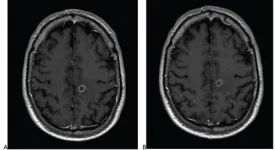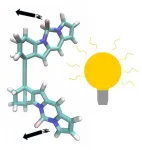Algorithm uses mass spectrometry data to predict identity of molecules
New method saves time, money in developing new drugs
2021-06-17
(Press-News.org) An algorithm designed by researchers from Carnegie Mellon University's Computational Biology Department and St. Petersburg State University in Russia could help scientists identify unknown molecules. The algorithm, called MolDiscovery, uses mass spectrometry data from molecules to predict the identity of unknown substances, telling scientists early in their research whether they have stumbled on something new or merely rediscovered something already known.
This development could save time and money in the search for new naturally occurring products that could be used in medicine.
"Scientists waste a lot of time isolating molecules that are already known, essentially rediscovering penicillin," said Hosein Mohimani, an assistant professor and part of the research team. "Detecting whether a molecule is known or not early on can save time and millions of dollars, and will hopefully enable pharmaceutical companies and researchers to better search for novel natural products that could result in the development of new drugs."
The team's work, "MolDiscovery: Learning Mass Spectrometry Fragmentation of Small Molecules," was recently published in Nature Communications. The research team included Mohimani; CMU Ph.D. students Liu Cao and Mustafa Guler; Yi-Yuan Lee, a research assistant at CMU; and Azat Tagirdzhanov and Alexey Gurevich, both researchers at the Center for Algorithmic Biotechnology at St. Petersburg State University.
Mohimani, whose research in the Metabolomics and Metagenomics Lab focuses on the search for new, naturally occurring drugs, said after a scientist detects a molecule that holds promise as a potential drug in a marine or soil sample, for example, it can take a year or longer to identify the molecule with no guarantee that the substance is new. MolDiscovery uses mass spectrometry measurements and a predictive machine learning model to identify molecules quickly and accurately.
Mass spectrometry measurements are the fingerprints of molecules, but unlike fingerprints there's no enormous database to match them against. Even though hundreds of thousands of naturally occurring molecules have been discovered, scientists do not have access to their mass spectrometry data. MolDiscovery predicts the identity of a molecule from the mass spectrometry data without relying on a mass spectra database to match it against.
The team hopes MolDiscovery will be a useful tool for labs in the discovery of novel natural products. MolDiscovery could work in tandem with NRPminer, a machine learning platform developed by Mohimani's lab, that helps scientists isolate natural products. Research related to NRPminer was also recently published in Nature Communications.
INFORMATION:
ELSE PRESS RELEASES FROM THIS DATE:
2021-06-17
Leesburg, VA, June 17, 2021--According to ARRS' American Journal of Roentgenology (AJR), a reduced dose of gadobutrol is non-inferior to 100%-standard dose of gadoterate for contrast-enhanced brain MRI.
"A 25% reduced gadobutrol dose demonstrated non-inferior efficacy versus standard dose gadoterate for contrast-enhanced brain MRI," corresponding author Jan Endrikat of Germany's University Medical School of Saarland elaborated, "warranting particular consideration in patients undergoing multiple contrast-enhanced examinations."
In this international, prospective, multicenter, open-label, crossover trial (LEADER-75), 141 patients (78 men, 63 women; mean age, 58.5 years) with known or suspected CNS pathology ...
2021-06-17
Type 1 diabetes is a disorder in which the immune system inappropriately targets a class of cells in the pancreas known as β cells that produce the hormone insulin, which plays an important role in regulating bloodstream glucose levels and the metabolism of carbohydrates, lipids, and proteins. The loss of insulin causes a range of health problems for people with type 1 diabetes, and patients become dependent on insulin injections for their survival. Even with insulin therapy, people with type 1 diabetes have shortened lifespans and are at an elevated risk of developing myriad complications.
Previous studies have identified numerous genetic risk factors for type 1 diabetes. One notable finding is the importance of the HLA region, a part of the human ...
2021-06-17
New technologies allow users to do things like race their real bikes against other real people in a virtual world, and a new study outlines what motivates people to use these online platforms. The findings offer insights for future iterations of these technologies - and how to market them.
At issue are "mixed-reality sports": augmented reality platforms that incorporate virtual, online elements and real-world athletic endeavors. For example, Zwift is a platform that allows users to ride their real bicycles, but transfers their efforts to a virtual space depicting real-world courses - allowing them to race against other cyclists who are not physically present.
"We ...
2021-06-17
Medical guidelines help doctors understand the best way to treat health conditions. Surprisingly, many doctors do not adhere to them, and this is a problem, according to a new study by scientists at University of Utah Health and MDGuidelines. People with lower back pain injury miss 11 more days of work in a year when they only receive treatments for lower back pain that are not recommended by medical guidelines compared to people treated according to guidelines. The findings publish in END ...
2021-06-17
Light-driven molecular motors have been around for over twenty years. These motors typically take microseconds to nanoseconds for one revolution. Thomas Jansen, associate professor of physics at the University of Groningen, and Master's student Atreya Majumdar have now designed an even faster molecular motor. The new design is driven by light only and can make a full turn in picoseconds, using the power of a single photon. Jansen: 'We have developed a new out-of-the-box design for a motor molecule that is much faster.' The design was published in The Journal of Physical Chemistry ...
2021-06-17
When astronomers using NASA's Hubble Space Telescope uncovered an oddball galaxy that looked like it didn't have much dark matter, some thought the finding was hard to believe and looked for a simpler explanation.
Dark matter, after all, is the invisible glue that makes up the bulk of the universe's matter. All galaxies appear to be dominated by it; in fact, galaxies are thought to form inside immense halos of dark matter.
So, finding a galaxy lacking the invisible stuff is an extraordinary claim that challenges conventional wisdom. It would have the potential to upset theories of galaxy formation and evolution.
To bolster their original finding, first reported in 2018 ...
2021-06-17
The intestinal disease necrotizing enterocolitis is a leading cause of death among premature infants born in the U.S. and across the globe. Characterized by excessive inflammation that can cause tissue decay in the bowels, the disease provides a pathway for infectious and deadly bacteria to enter the bloodstream.
Despite four decades of research, effective treatments remain elusive, and mortality rates in babies who develop the disease have remained essentially unchanged, hovering at about 30%.
Now, a study led by researchers at Washington University ...
2021-06-17
Personalised coaching through a smartphone platform can help women improve their lifestyle behaviours in the period before and shortly after they become pregnant, a new study has shown. The biggest reduction in behaviours that pose risks to pregnancy were seen in overweight women.
The findings, published in the journal Reproductive Biomedicine Online, show that digital healthcare could be a cost-effective way to deliver tailored advice to women who experience difficulties in pregnancy, which the NHS does not have the resources to provide.
In this study, led by the University of Southampton, 262 women who were planning pregnancies and had either experienced difficulties in conceiving or recurrent miscarriages signed ...
2021-06-17
June 17, 2021 - Nutley, NJ - Tiny genetic markers, circulating in the blood, have shown great promise in diagnosing and treating disease. Yet identifying and harvesting these extracellular vesicles (EVs) have been a major challenge for science.
Now a laboratory at the Hackensack Meridian Center for Discovery and Innovation (CDI) has discovered a highly sensitive methodology that can efficiently find and harness EVs - particularly exosomes and the micro RNAs they carry. These could be crucial clues to identifying diseases such as cancer early on in its development.
The scientists have now unveiled the Extracellular Vesicle Capture by AnTibody of CHoice and 1 Enzymatic Release, or EV-CATCHER, in the Journal of Extracellular Vesicles.
"We are establishing the threshold ...
2021-06-17
TAMPA, Fla. (June 17, 2021) - Tests that analyze biomarkers are used during cancer management to guide treatment and provide information about patient prognosis. These tests are often performed on tissue biopsy samples that require invasive procedures and can lead to significant side effects. In a new article published in the Journal for ImmunoTherapy of Cancer, Moffitt Cancer Center researchers show that PET/CT images can be used to measure levels of the PD-L1 biomarker of non-small cell lung cancer (NSCLC) patients in a non-invasive manner and, in turn, predict a patient's response to therapy. ...
LAST 30 PRESS RELEASES:
[Press-News.org] Algorithm uses mass spectrometry data to predict identity of molecules
New method saves time, money in developing new drugs



